How to ship appliances according to Whirlpool:
Appliances are common goods that perform essential functions that you can find in almost every home. For these reasons, appliances are always in demand by consumers. Even before the pandemic, sales of appliances were on the rise.
| 2015 | $40.14 |
| 2016 | $41.47 |
| 2017 | $43.33 |
| 2018 | $44.23 |
| 2019 | $45.69 |
Since there is so much demand for appliances, it’s important to know how to ship them safely to keep your customers satisfied.
Need help shipping an industrial sewing machine? Check out our article.
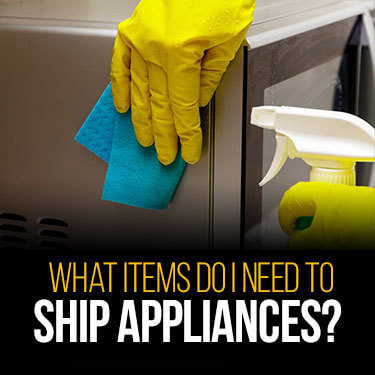
Before you start preparing your appliances for shipping, you should first obtain some items you’ll need to prepare and pack your appliances. First, get a few cleaning supplies that you can use to freshen up your appliances before packing them up. Some cleaning supplies you should use are:
These materials can be used to clean just about all kinds of appliances, whether they be stainless steel or not. Next, you’re going to need some materials that you’ll use to pack your appliances. These materials are:
Appliances can still sustain damage when they’re shipped within the confines of a box or crate. To prevent this from happening, use any of the packing materials listed below to make sure your appliances receive the protection they need for their journey:
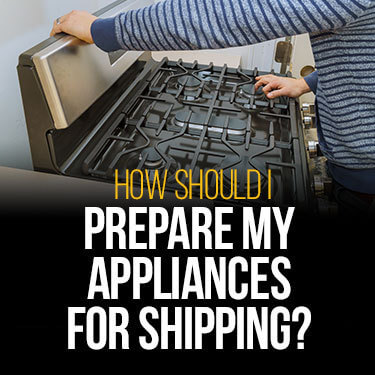
Now that you have all the materials you’ll need to move appliances, you can get down to preparing them for shipment. These steps will ensure that your appliances look pristine and excellent condition when they arrive at their destination.
The first part of preparing appliances for transport is cleaning them thoroughly. Used appliances will need cleaning the most, but even brand-new appliances that have yet to be used can benefit from being spiffed up a bit.
Cleaning the surface appliances is fairly easy. Simply apply whatever cleaning solution you’ve chosen to the surface of the appliance. Then, start scrubbing the solution in with some type of non-abrasive cloth. When it comes to cleaning the interior of appliances, the steps you’ll follow will get a bit more lengthy.
For example, you’ll need to do the following things to clean the inside of a refrigerator:
Removing the items within an appliance to clean them separately is a procedure that applies not only to refrigerators but to other types of appliances like ovens, air fryers and certain types of toasters. That said, the cleaning procedures you’ll have to follow when shipping a washer are much different and more complex. To keep the inside of a washer clean, you’ll have to do the following:
Any appliances that come with attachments will need to have their attachments removed and cleaned separately as well. Appliances with attachments on them include the following:
Shipping off new appliances that have been freshly cleaned is a great way to leave a good impression on a retailer or customer who ordered the appliance.
Check out our article on domestic Incoterms so you and your receiver can better understand each other.
Disabling power to the appliances you want to ship is pretty simple. First, make sure that your appliance is not in operation and is switched off. Afterward, simply disconnect your appliance from its power source.
Most appliances are plugged directly into an electrical outlet, but some use gas as their source of power. Regardless of how your appliance is powered, be sure you disconnect them from the power source safely and correctly.
When you need to ship a washer and dryer, you’ll need to take the added step of disconnecting the washer from the water source. You can typically find the valves that control the water source on the wall behind the washer.
Once that’s done, you can remove the hoses of your washer. There will be some leftover water in these hoses, so it’s important to make sure that you drain the hoses completely. Any leftover water will likely leak, causing the box holding your appliance to get soggy and weakening its integrity.
When it comes to shipping large appliances, you’re going to have to deal with securing attachments that come with them. Some of the loose parts that come with various appliances include some of the following:
Some loose parts and attachments can be shipped while attached to the appliance while others can’t. If you can secure an attachment to an appliance without the attachment bouncing around or coming loose, then you won’t need to ship it separately. Cords that are attached to your appliance are a bit trickier to secure. One simple solution is to use some painters to tape the cord to the appliance.
Washing machines, also pose a unique challenge for this part of the shipping process. That’s because the washer’s drum is likely to swing around inside the washer while the appliance is in transit.
This can cause potential damage to the drum and the inside of the washer as well. To secure the washing drum, simply follow these simple solutions:
Any of these options will keep the drum safe while it’s in transit.
Check out our article on how to negotiate freight rates once you're ready to ship.
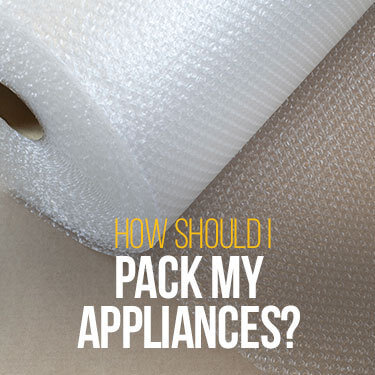
Now that you’ve made all of the necessary preparations to ship your home products, you can now move on to packing them for transport. Packing your appliances safely is the only way to guarantee that they will be protected from most impacts that can cause them damage.
The first step you should take when packing your appliances for transport is by packing loose parts and attachments for appliances separately. If you’ve determined that you can’t secure attachments to your appliance, then follow these steps:
Attachments that can be secured to an appliance can be packed with the appliance they correspond with. This can be done by placing the attachment onto the appliance and wrapping the entire object in packing material. Another option would be to secure the attachment with tape and then wrap the object in your chosen packing material.
Packing the appliance in its entirety is similar to packing appliance attachments, but with some extra steps that can vary by appliance. The steps that you should take are:
Using the stretch wrap to close the doors or hatches is something you’ll only need to do for certain appliances like coffee makers, certain types of toasters, air fryers and refrigerators. This part can be skipped if the appliance you’re shipping doesn’t have these features.
When wrapping large appliances with packing materials, make sure you have enough to cover the entirety of the product. Measuring the dimensions of your appliances will help you discern how much packing material you’ll need to cover them.
The hardest part of packing your appliance is getting it inside its box. While this might not be particularly difficult for lighter appliances, heavier ones like stoves, refrigerators and washers and dryers can be challenging. To do this, make sure you have some assistance from another person.
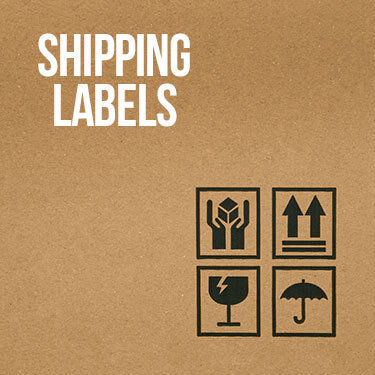
After all of the packing, proceedings are taken care of, you can start to place shipping labels on the outside of the box. Fortunately, shipping companies don’t require too much on the box of an appliance to perform their delivery services. A simple shipping label with the following information will be more than enough for them to determine where the freight you’re sending needs to go:
As long as shipping labels have this information printed on them, it doesn’t matter what format the shipping label is in. Some labels that you should include to communicate the fragile nature of your appliances are:
For some appliances, you might want to put labels saying “THIS SIDE UP” with arrows pointed in the upward direction. You might be able to find boxes that have these warning labels already printed on them.
Palletizing your appliance shipments is an option that you can explore. When deciding whether or not to palletize, you should consider the following factors:
If you plan to ship one or a few small appliances like a coffee maker or crock pot, then you can ship your goods off as a non-palletized LTL freight shipment. However, large quantities of small appliances or large appliances should be transported on pallets.
A pallet will help for shipments like these because they:
Additionally, pallets are useful when you need to ship an FTL appliance shipment.
Having the right paperwork for a domestic freight shipment is essential, regardless of what type of freight you’re shipping. Many of the documents needed for a domestic freight shipment are easy to find and fill out. The purpose of these documents is to communicate information needed by both the carrier providing the shipping services and the receiver of the freight.
Hazardous goods can be a real pain to ship due to all of the regulations surrounding them. Unfortunately, certain appliances are considered HAZMAT and you will be required to follow all related regulations if you want to ship your goods successfully.
A common appliance that is considered HAZMAT is refrigerators. If you’ve determined that the appliance you’re shipping is hazardous, you’ll need to follow the HAZMAT regulations enforced by the Department of Transportation (DOT) outlined in Title 40 of the Code of Federal Regulations (CFR).
Some of the responsibilities that will be expected of you as a shipper of hazardous goods include:
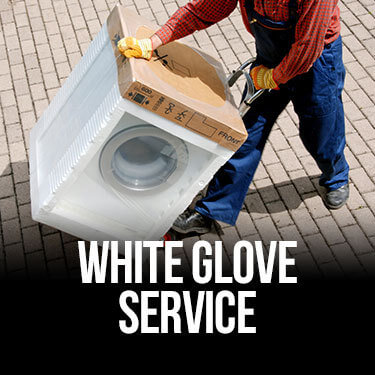
As you’ve probably noticed, shipping large appliances is no easy task, especially when it comes to unloading them or installing them in your home. A customer that has ordered an appliance from you might have trouble with these aspects of the shipping process. One thing that you might want to offer to them to make their lives easier and establish a good relationship with them are white glove services.
This type of service is offered by various carriers and caters specifically to customers who have ordered large appliances. The service works by delivering an appliance to a place of business or a customer's home. Afterward, the delivery men perform the installation service on the customer's behalf.
We’ve already discussed how handling the wiring and hoses on appliances like refrigerators and washers when shipping can be a hassle. Installing them after they’ve arrived can be just as troublesome. Therefore, offering white glove delivery is one way you can provide some much-needed help to a customer.
You can learn more about this service in our article on white glove appliance delivery.
At USA Truckload, we ship just about all kinds of freight. Whether you have an FTL shipment or an LTL shipment, one of the many small carriers that we partner with can transport your appliances wherever they need to go. Some of the carriers that we partner with can even transport your freight and provide white glove delivery services.
In addition to our array of reliable partners, we provide shipping insurance. Even when you pack your freight correctly, freak accidents can always occur and potentially damage your goods. It’s important to have the coverage you need in case such an incident occurs.
Another service that we offer that our customers have found useful is consulting services. At USA Truckload, we understand how daunting shipping freight can be. With our consulting services, you can ask one of our professionals any question you have in regard to shipping appliances.
If you’re ready to ship your appliances, fill out your quote immediately. If you have questions you’d like some answers to, reach out to our team and ask about setting up a consulting session at (866) 353-7178.
R+L Global Logistics
315 NE 14th St., Ocala, FL 34470